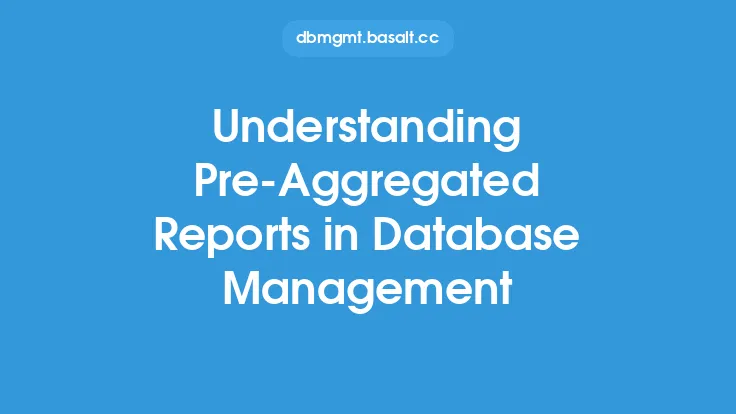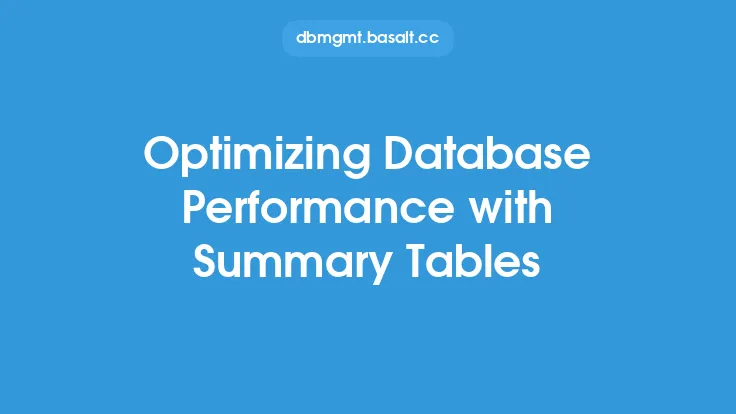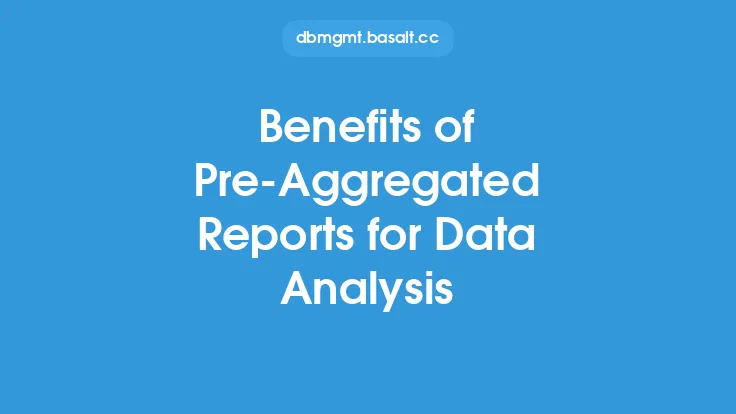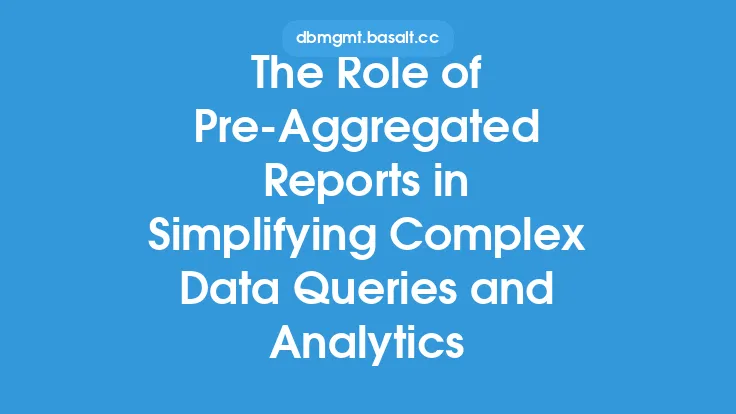Database performance is a critical aspect of any data-driven application, and optimizing it can significantly impact the overall user experience and business outcomes. One effective technique for optimizing database performance is the use of pre-aggregated reports. Pre-aggregated reports involve storing aggregated data in a separate table or data structure, which can be used to quickly generate reports and answer complex queries. In this article, we will explore the concept of pre-aggregated reports and how they can be used to optimize database performance.
Introduction to Pre-Aggregated Reports
Pre-aggregated reports are a type of data denormalization technique that involves storing aggregated data in a separate table or data structure. This allows for fast and efficient querying of the data, without having to perform complex calculations or aggregations on the fly. Pre-aggregated reports can be used to store a wide range of aggregated data, including sums, averages, counts, and more. By storing this data in a separate table, queries can be executed much faster, as the database does not have to perform the aggregations in real-time.
How Pre-Aggregated Reports Work
Pre-aggregated reports work by storing aggregated data in a separate table or data structure. This table is typically updated periodically, such as daily or weekly, to reflect changes in the underlying data. When a query is executed, the database can simply retrieve the pre-aggregated data from the separate table, rather than having to perform the aggregations on the fly. This can significantly reduce the time it takes to execute complex queries, and can also reduce the load on the database.
Benefits of Pre-Aggregated Reports
Pre-aggregated reports offer a number of benefits for optimizing database performance. One of the primary benefits is improved query performance. By storing aggregated data in a separate table, queries can be executed much faster, as the database does not have to perform complex calculations or aggregations on the fly. This can significantly improve the overall user experience, as users do not have to wait as long for queries to execute. Pre-aggregated reports can also reduce the load on the database, as the database does not have to perform as many complex calculations or aggregations. This can help to improve the overall performance and scalability of the database.
Types of Pre-Aggregated Reports
There are several types of pre-aggregated reports that can be used to optimize database performance. One common type is a summary table, which stores aggregated data for a specific set of data. For example, a summary table might store the total sales for each region, or the average order value for each customer segment. Another type of pre-aggregated report is a rollup table, which stores aggregated data for a specific set of data, as well as for higher-level groupings. For example, a rollup table might store the total sales for each region, as well as for each country or continent.
Designing Pre-Aggregated Reports
Designing pre-aggregated reports requires careful consideration of the types of queries that will be executed, as well as the underlying data structure. One key consideration is the level of granularity required for the pre-aggregated data. For example, if the pre-aggregated data will be used to generate reports by region, the data should be aggregated at the regional level. Another key consideration is the frequency with which the pre-aggregated data will be updated. For example, if the data will be updated daily, the pre-aggregated data should be updated daily as well.
Implementing Pre-Aggregated Reports
Implementing pre-aggregated reports requires a number of steps, including designing the pre-aggregated report, creating the necessary tables or data structures, and updating the pre-aggregated data on a regular basis. One key consideration is the method used to update the pre-aggregated data. For example, the data can be updated using a batch process, or using a real-time data integration technique. Another key consideration is the data storage requirements for the pre-aggregated data. For example, the data may require a significant amount of storage space, depending on the level of granularity and the frequency of updates.
Maintenance and Updates
Pre-aggregated reports require regular maintenance and updates to ensure that the data remains accurate and up-to-date. One key consideration is the frequency with which the pre-aggregated data should be updated. For example, if the data is updated daily, the pre-aggregated data should be updated daily as well. Another key consideration is the method used to update the pre-aggregated data. For example, the data can be updated using a batch process, or using a real-time data integration technique. Regular maintenance and updates can help to ensure that the pre-aggregated reports remain accurate and effective, and can help to optimize database performance over time.
Common Challenges and Limitations
While pre-aggregated reports can be a powerful technique for optimizing database performance, there are several common challenges and limitations to consider. One common challenge is the complexity of designing and implementing pre-aggregated reports. For example, the reports may require complex calculations or aggregations, and may need to be updated on a regular basis. Another common challenge is the storage requirements for the pre-aggregated data. For example, the data may require a significant amount of storage space, depending on the level of granularity and the frequency of updates. Despite these challenges and limitations, pre-aggregated reports can be a highly effective technique for optimizing database performance, and can help to improve the overall user experience and business outcomes.
Best Practices for Pre-Aggregated Reports
There are several best practices to consider when implementing pre-aggregated reports. One key best practice is to carefully design the pre-aggregated report, taking into account the types of queries that will be executed, as well as the underlying data structure. Another key best practice is to regularly update the pre-aggregated data, to ensure that the data remains accurate and up-to-date. Additionally, it is important to consider the storage requirements for the pre-aggregated data, and to ensure that the data is properly indexed and optimized for query performance. By following these best practices, organizations can help to ensure that their pre-aggregated reports are effective and efficient, and can help to optimize database performance over time.
Conclusion
Pre-aggregated reports are a powerful technique for optimizing database performance, and can help to improve the overall user experience and business outcomes. By storing aggregated data in a separate table or data structure, queries can be executed much faster, and the load on the database can be reduced. While there are several common challenges and limitations to consider, pre-aggregated reports can be a highly effective technique for optimizing database performance, and can help to improve the overall efficiency and effectiveness of the database. By carefully designing and implementing pre-aggregated reports, and by following best practices for maintenance and updates, organizations can help to ensure that their pre-aggregated reports are effective and efficient, and can help to optimize database performance over time.





